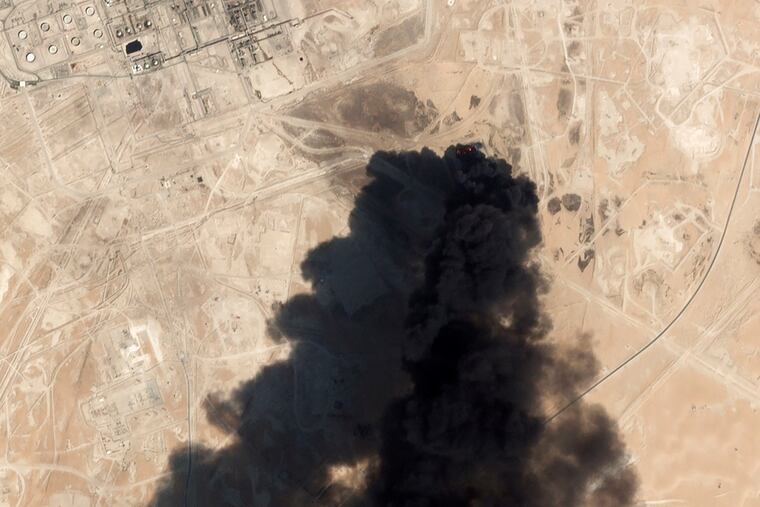Oil prices jump after strikes cut Saudi Arabia’s output in half; Trump says U.S. to tap strategic reserves
Oil prices jumped on global markets Sunday night after a wave of weekend drone attacks instantly erased half of Saudi Arabia's oil production.

Oil prices jumped on global markets Sunday night after a wave of weekend drone attacks instantly erased half of Saudi Arabia's oil production.
Brent crude traded at $70.98 per barrel on oil futures markets Sunday evening, an 18 percent surge from Friday's close of $60.15, before falling back to a 12 percent jump. U.S. benchmark West Texas intermediate crude opened at $61.27 per barrel, a 12 percent climb.
In a tweet, Trump said he authorized the release of oil from the Strategic Petroleum Reserve in a to-be-determined amount. He added that he told government agencies "to expedite approvals of the oil pipelines currently in the permitting process in Texas and various other States."
The attack on Saudi Arabia's oil infrastructure immediately knocked out 5.7 million barrels - nearly 6 percent - from the 100 million barrels per day that the world consumes.
"A supply disruption on this scale is an extraordinary event," said Pavel Molchanov, an oil analyst with Raymond James. "No single disruption on this scale has occurred in decades."
U.S. oil prices have been trading between $50 and $60 a barrel in the past six months. Brent crude, the global benchmark, has been trading slightly above that range. Most oil companies and nations favor world oil prices in the $70 to $80 range, which allows a healthy profit without rattling the economy or sparking a rush for alternatives to petroleum.
Oil prices could spike in the next several days as a result of the attack on Saudi's state-run oil company, Saudi Aramco, which is the second-largest oil producer in the world, at 9.85 million barrels per day in August.
"The Saudis are scrambling to make repairs and keep the oil flowing," said John Kilduff of Again Capital. "The response will determine how high prices go and for how long."
A jump in oil prices will likely weigh on an already-declining global economy, one beset by the U.S.-China trade war, White House sanctions against Iran and a decade-long economic expansion that shows signs of petering out.
On Sunday, Saudi officials said only a third of the affected 5.7 million barrels would be restored by Monday, leaving millions of barrels a day offline indefinitely.
With oil giants Venezuela and Iran mostly absently from world markets, an extended Saudi supply disruption could force industrial economies to tap emergency reserves, like the U.S. will do. There are 1.5 billion barrels available in strategic reserves among industrial economies.
The U.S. Strategic Petroleum Reserve holds 645 million barrels, equal to about one month of U.S. oil consumption.
"The good news is that there is more than enough oil in inventory to prevent fuel shortages," Molchanov said. "There are not going to be gasoline lines like there were in the 1970s."
Though Yemen's Houthi rebels claimed responsibility for the weekend blasts, the U.S. blames Iran for the "unprecedented attack on the world's energy supply." Tehran has denied responsibility.
The last time the world lost a comparable slice of its oil supply was during the 1991 Persian Gulf War. As a result, there was a substantial increase in global oil prices, but the process was gradual because the war had been expected.
Oil prices result from a careful balance of supply and demand. Supplies have been mostly in balance this year, as U.S. production has made up for declines in Venezuela and Iran.
Even through the U.S. produces more oil than ever before - close to 12 million barrels a day - a disruption halfway around the world can send prices soaring on global markets.
"The Saudis are scrambling to make repairs and keep the oil flowing by taking it from storage," said analyst John Kilduff of Again Capital. "The response to the attack will determine how high prices go and for how long."
But Americans are more insulated from dramatic swings because technological advances have increased domestic oil output and heightened efficiency, from automobile mileage to home heating. U.S. shale oil production has reduced domestic demand for Persian Gulf oil from 3 million barrels a day in 2003 to 1 million barrels now. The U.S. economy is much less dependent on manufacturing than it was during the big oil price spikes of the 1970s and '80s.
Oil companies also are a smaller piece of the stock market. The energy sector constituted more than 20 percent of the Standard & Poor's 500's total value in the 1970s. Now it's 4.44 percent.
Oil prices have been relatively calm in recent weeks because of high production and slowing demand. But trade disputes, sanctions against Iran, and Venezuela's internal meltdown have contributed to confusion in oil markets.
U.S. oil production has helped keep a lid on gasoline prices. Americans this month saw the lowest Labor Day gas prices in three years.
Saudi Arabia has been the industry's great stabilizer, with $10 trillion worth of oil under its sands. But the kingdom and other members of the Organization of the Petroleum Exporting Countries have been unable to limit production enough to keep prices within the sweet spot of $70 to $80 a barrel.
“This attack provides a stark reminder that geopolitical risk to oil supply is very real,” Molchanov said.